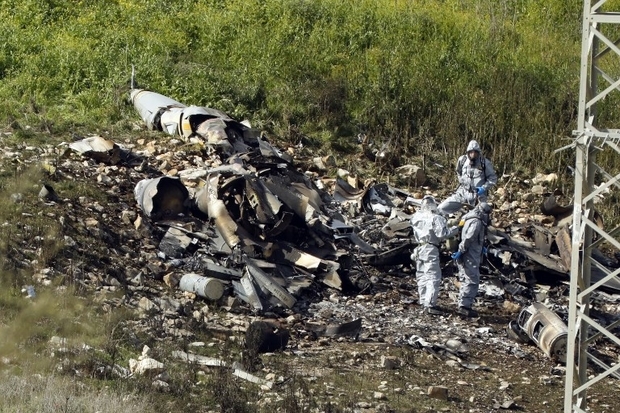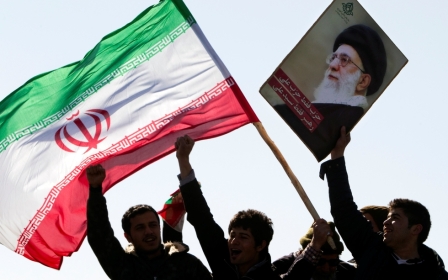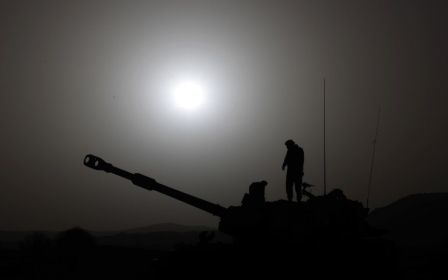Will the Iran-Israel conflict in Syria lead to war?

A chain of events, allegedly beginning with an Iranian drone penetrating Israeli airspace on Saturday followed by the downing of an Israeli F-16 fighter by Syrian forces, led to a large-scale military strike in which Israel bombed a dozen of Syrian and Iranian targets on Syrian soil.
Hossein Salami, the deputy commander of the Iranian Revolutionary Guards Corps (IRGC) and one of the most radical figures in Iran's establishment, rejected Israel's claims. Salami expressed Iran's official position that its military presence in Syria is limited to that of military advisers.
He added that Iran can "create hell" for the Zionists and hit all American bases in the region, clearly indicating that Iran is not interested in a direct confrontation with Israel, at least at this point.
However, as the news broke, a group of observers rushed to conclude that this could explode into a far-reaching, head-on clash between Iran and Israel. Was this conclusion premature? Yes, probably.
Survival of nezam first
The bottom line for the Iranian establishment, like any other state or regime, is survival. The Islamic Republic has shown spectacular restraint on a number of occasions when it has determined that retaliation or confrontation may jeopardise the survival of its system. Consider the following.
The leader of the Iranian Revolution, Ayatollah Ruhollah Khomeini, founded the basis of Iran’s foreign policy in the post-revolution era, the pillar of which was an anti-Israel, hostile position
The leader of the Iranian Revolution, Ayatollah Ruhollah Khomeini, founded the basis of Iran's foreign policy in the post-revolution era, the pillar of which was an anti-Israel, hostile position.
However, in a glaring example during the 1982 Israeli invasion of Lebanon, one can clearly see how Khomeini avoided a military confrontation with Israel that would have jeopardised the survival of nezam (establishment). Khomeini repeatedly said that protecting nezam was the highest duty of all.
In June 1982, the Israelis launched a massive attack on Lebanon with the goal of forcing the Palestinian Liberation Organisation (PLO) out of the country. The attack led to the death of thousands of people. This move came three years after the victory of the revolution in Iran, when many young people competed to join the war against Iraq and die as martyrs (the Iraq-Iran war began in 1980 and ended in 1988).
Iran Air flight 655
When Iraq invaded Iran in 1980, the United States supported Iraqi leader Saddam Hussein against the two countries' mutual enemy: Iran. The war dragged on for eight years, claiming one million lives. On 3 July 1988, Iran Air Flight 655 took off from Bandar Abbas International Airport in southern Iran, bound for Dubai.
A US Navy ship called the Vincennes strangely enough mistook the large Airbus A300 civilian airliner for a much smaller and faster F-14 fighter jet. It fired two surface-to-air missiles, killing all 290 passengers and crew members on board.
The event triggered an intense international controversy, with Iran condemning the US attack as a "barbaric act". Many flaws were detected in the American version of the incident. Immediately afterwards, Ayatollah Hossein Ali Montazeri, who at the time was the designated successor of Ayatollah Khomeini, wrote Khomeini a letter and asked him to declare jihad against the US.
In response, Khomeini responded: "Your message was a relief to the pains of all who have been victimised by the Great Satan. … You are one of the precious members of this revolution … Dedicate your time to building a world filled with chivalry and generosity."
When Iraq invaded Iran in 1980, the United States supported Iraqi leader Saddam Hussein against the two countries’ mutual enemy: Iran. The war dragged on for eight years, claiming one million lives
Two weeks later, Iran accepted the truce with Iraq, while observers almost unanimously expected an escalation in the Persian Gulf between Iran and the US Navy. In an open letter, Ayatollah Khomeini wrote: "Taking this decision was more deadly than taking poison. I submitted myself to God's will and drank this chalice of poison for his satisfaction."
He added :"I had promised to fight to the last drop of my blood and to my last breath." Despite this promise, Khomeini changed his mind "based only on the interest of the Islamic republic" of Iran.
A former Iranian president, then commander-in-chief, Akbar Hashemi Rafsanjani, later said in an interview: "Until the incident of the shooting [down] of the passenger plane by the US, there was no discussion about accepting UN Resolution 598 whatsoever [urging an Iran-Iraq ceasefire]".
Taliban killing Iranian diplomats
In 1998 the Taliban, sworn enemies of the Shias, attacked the Iranian consulate in Mazar Sharif, capturing and killing nine Iranians, eight of them diplomats. Following the incident, Iran amassed 100,000 troops at the Afghanistan border.
The members of the Supreme National Security Council (SNSC), including the mellow-tempered president Mohammad Khatami, overwhelmingly voted for attacking Afghanistan.
An Iranian diplomat familiar with the case told this writer that those who were opposed to going to war argued that Iran's national security was not threatened to the extent that would warrant a forceful response.
Domestic challenges
Iran is currently facing monumental domestic challenges. While the recent protests did not lead to a popular uprising, they were geographically vast. Riots spread to 80 towns and cities, arguably the broadest in geographical terms since the inception of the Islamic Republic. The prevalent dissatisfaction within Iranian society is believed to have roots in economic hardships.
A conspicuous indication showing the seriousness of domestic unrest to the Iranian leaders is that in the wake of recent protests, the Iranian leader, Ayatollah Ali Khamenei, took an unprecedented step. He ordered both the country's regular army and the IRGC to divest from commercial holdings and businesses not directly affiliated with their work.
Given that the IRGC controls almost one-third of Iran's economy, according to some estimates, the move may lead to a tectonic shift toward the liberalisation of the economy. Will this reform work? Perhaps not. But the move shows that the leadership has detected vulnerability.
Putting these indications together, it could be concluded that Iran will not involve itself in a war with Israel over its position in Syria, over Israel attacking Lebanon in an attempt to demolish Hezbollah, or over any other indirect confrontation initiated by Israel. Iran will only involve itself in a defensive war if it is attacked directly by Israel and the survival of nezam is seriously threatened.
- Shahir Shahidsaless is an Iranian-Canadian political analyst and freelance journalist writing about Iranian domestic and foreign affairs, the Middle East, and the US foreign policy in the region. He is the co-author of Iran and the United States: An Insider’s View on the Failed Past and the Road to Peace. He is a contributor to several websites with focus on the Middle East as well as the Huffington Post. He also regularly writes for BBC Persian. He tweets @SShahisaless.
The views expressed in this article belong to the author and do not necessarily reflect the editorial policy of Middle East Eye.
Photo: A man carries a giant flag made of flags of Iran, Palestine, Syria and Hezbollah, during a ceremony marking the 37th anniversary of the Islamic Revolution, in Tehran 11 February, 2016 (REUTERS)
This article is available in French on Middle East Eye French edition.
New MEE newsletter: Jerusalem Dispatch
Sign up to get the latest insights and analysis on Israel-Palestine, alongside Turkey Unpacked and other MEE newsletters
Middle East Eye delivers independent and unrivalled coverage and analysis of the Middle East, North Africa and beyond. To learn more about republishing this content and the associated fees, please fill out this form. More about MEE can be found here.







